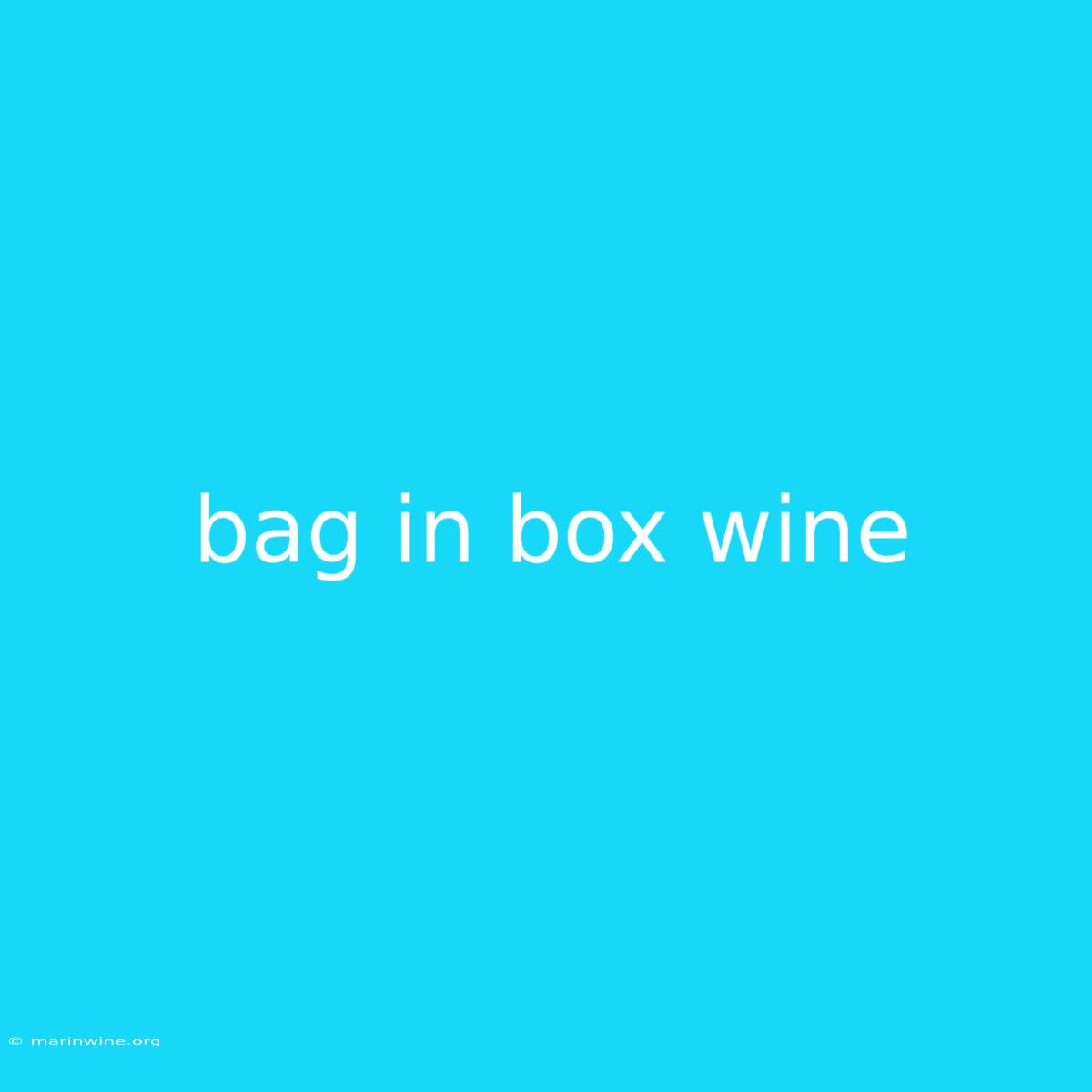Bag-in-Box Wine: Is This the Future of Wine Drinking?
Ever wondered why you see those strange rectangular containers at the grocery store? They’re not just for juice anymore! Bag-in-box wine is rapidly gaining popularity, and for good reason.
Why It Matters: The world of wine is constantly evolving, and bag-in-box is leading the charge. This format offers a sustainable, convenient, and often more affordable way to enjoy your favorite wines.
Key Takeaways of Bag-in-Box Wine:
| Takeaway | Description |
|---|---|
| Sustainability | Reduced packaging waste compared to glass bottles. |
| Convenience | Easy storage, no cork screw needed, and pours fresh every time. |
| Affordability | Often priced lower than bottled wine, making it an attractive option for everyday drinking. |
| Quality | Bag-in-box technology has advanced, resulting in high-quality wines that can rival bottled offerings. |
Bag-in-Box Wine: Unpacking the Details
What is Bag-in-Box Wine?
Bag-in-box wine is precisely what it sounds like: wine contained in a flexible bag inside a cardboard box. This method of packaging has been around for decades but has recently seen a resurgence in popularity due to its numerous benefits.
Key Aspects of Bag-in-Box Wine
1. Packaging:
- The bag is typically made of a multi-layered, food-grade plastic that protects the wine from light and oxygen.
- The cardboard box provides added protection and helps maintain a stable temperature.
- Some boxes feature a tap or spout for easy pouring.
2. Wine Quality:
- Many producers are now using high-quality grapes and vinification techniques for their bag-in-box wines.
- The bag's barrier properties help preserve the wine's freshness, ensuring a consistent taste for weeks after opening.
3. Environmental Impact:
- Bag-in-box packaging uses significantly less material than glass bottles, minimizing waste and reducing carbon footprint.
- The reusable boxes can even be recycled, further contributing to sustainability.
Exploring the Connection Between Sustainability and Bag-in-Box Wine
The environmental impact of wine production is a growing concern. Bag-in-box offers a compelling solution by reducing waste and carbon emissions.
- Reduced Packaging: The packaging itself is a key factor. Using a flexible bag instead of a heavy glass bottle means less material is needed to transport the wine. This translates to less fuel consumption and fewer greenhouse gas emissions.
- Reusable Boxes: Many consumers reuse the boxes for various storage purposes after finishing the wine, extending the product's lifecycle and further reducing waste.
- Minimizing Transportation Costs: Lighter packaging means lower transport costs, which can be a significant factor in reducing the overall carbon footprint of wine production.
Understanding the Role of Wine Quality in Bag-in-Box
While some might associate bag-in-box with low-quality wines, this is a misconception. Today, several wineries produce high-quality wines specifically for bag-in-box packaging.
- Advanced Technology: The technology used to package and preserve wine in bags has advanced significantly, allowing for better protection and preservation.
- Increased Demand: The growing demand for bag-in-box has driven producers to focus on quality, leading to a wider variety of grape varieties and wine styles available in this format.
A Closer Look at the Economics of Bag-in-Box
One of the major advantages of bag-in-box wine is its affordability. This is primarily due to:
- Lower Packaging Costs: The cost of manufacturing and transporting flexible bags and cardboard boxes is significantly lower than producing and shipping glass bottles.
- Efficiency: Bag-in-box packaging allows producers to fill and seal the bags more efficiently, reducing labor costs.
FAQ for Bag-in-Box Wine
Q: How long does bag-in-box wine last after opening? A: Opened bag-in-box wine can typically last for several weeks, sometimes even months, if properly stored. The bag's barrier properties help protect the wine from oxidation.
Q: Can I find high-quality wines in bag-in-box format? A: Yes, many wineries now produce high-quality wines specifically for bag-in-box packaging. Look for reputable brands and wines with positive reviews.
Q: Is bag-in-box wine good for parties and gatherings? A: Absolutely! The convenient format makes bag-in-box ideal for parties and gatherings. You can easily pour multiple glasses without worrying about refilling bottles.
Q: What types of wines are available in bag-in-box? A: You can find a wide variety of wines in bag-in-box, including red, white, rosé, and even sparkling wines.
Q: How do I choose the right bag-in-box wine? A: Consider your preferences in terms of grape variety, wine style, and price. Look for wines with positive reviews from reputable sources.
Q: What is the best way to store bag-in-box wine?
A: Store unopened bag-in-box wine in a cool, dark place. Once opened, refrigerate the box to prolong the wine's freshness.
Tips for Enjoying Bag-in-Box Wine
- Consider the serving temperature: Chill white and rosé wines, serve reds at room temperature.
- Pair with food: Bag-in-box wine pairs well with a variety of dishes, from light salads to hearty stews.
- Don't be afraid to experiment: Explore different grape varieties and wine styles to find your favorites.
Summary of Bag-in-Box Wine
The world of wine is constantly evolving, and bag-in-box is proving to be a sustainable, convenient, and affordable way to enjoy your favorite wines. From environmental consciousness to quality improvements and diverse offerings, bag-in-box is not just a trend; it's a revolution in wine consumption.
Closing Message: It's time to embrace the bag-in-box revolution. You might be surprised by the quality and versatility of these innovative wines. So, next time you're at the store, consider grabbing a box and rediscovering the joy of wine.

